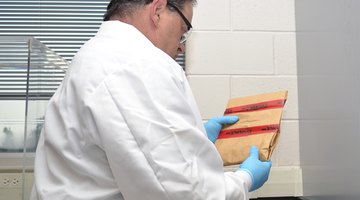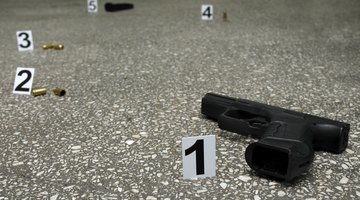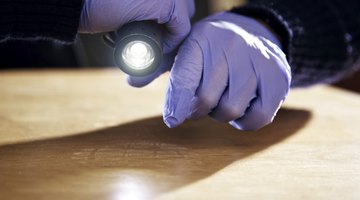Chemistry is used in forensic science to uncover information from physical evidence. In criminal cases, chemists analyze substances such as blood, DNA and gunpowder residue to attempt to determine when and by whom the crime was committed. In civil cases, chemists analyze DNA to authenticate valuable products and to identify fraudulent activity. Chemists also determine information from unsolved crimes and mysteries of long ago through other means of DNA analysis.
Blood Analysis

Aside from being used for identification of suspects, the contents of blood on a crime scene can be evaluated to reveal the presence of substances. For this evaluation, a chemist will perform a chromatography test, which uses intense heat to separate the blood into different contents. Afterward, a chemist determines the level of substances such as alcohol or medication that would affect the suspect´s actions and motivations during a given crime.
DNA Forensics in Criminal Cases

DNA forensics is used in criminal cases to match the DNA of an individual to that of body cells left at a crime scene, such as skin cells, hair, semen and blood. The FBI most commonly uses STR-analysis for its cases. With STR-analysis, chemists take DNA samples from areas at the crime scene. These are then compared with the DNA profiles of individuals booked in an expansive database called CODIS to identify suspects.
DNA Forensics in Civil Cases

DNA forensics is used in civil cases, such as fraud, forgery or negligence. For example, unique DNA strands were placed on Super Bowl XXXIV footballs as well as 2000 Summer Olympics memorabilia to provide a means of determining authenticity. In addition. DNA forensics are used to identify the purity and content of food, water and pharmaceuticals to ensure that they meet required legal standards.
Firearms Analysis

Chemistry is often used in crimes involving firearms in order to identify information from recovered bullets and residue. For example, a forensic scientist will examine a suspect´s hands and clothes with infrared lights to look for gunpowder residue. If this residue matches that of the bullet found in the victim, there is evidence that the suspect recently fired the same type of firearm responsible for harming the victim. If no gunpowder residue is found on a suspect, a chemical analysis of the bullet can still reveal information such as the type of firearm used and how long ago the bullet was fired.
Mitochonrial DNA

For recent events, forensic DNA analysis uses nuclear DNA to identify matches. However, over time, nuclear DNA material deteriorates, making it necessary to test other parts of the cell. Mitchondrial DNA (mtDNA) analysis is used to find matches in unsolved crimes from years ago. In addition, mtDNA can be used to solve claims and disputes by identifying persons and lineages from as long as 1,000 years ago.
Related Articles
References
Writer Bio
Justin Higgins has traveled throughout South America. He writes articles that appear on various websites with a focus on travel and science-related topics. Higgins is a graduate from Ithaca College with a Bachelor of Arts in cultural anthropology.











